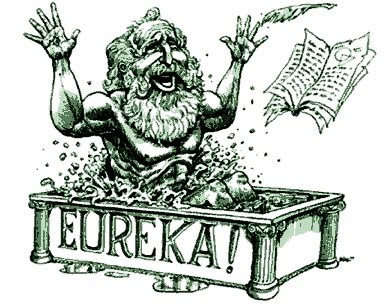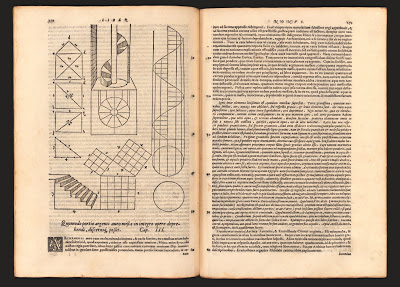Philosophy


Wikipedia...
This exclamation is most famously attributed to the ancient Greek scholar Archimedes; he reportedly proclaimed "Eureka!" when he stepped into a bath and noticed that the water level rose—he suddenly understood that the volume of water displaced must be equal to the volume of the part of his body he had submerged. This meant that the volume of irregular objects could be measured with precision, a previously intractable problem. He is said to have been so eager to share his realisation that he leapt out of his bathtub and ran through the streets of Syracuse naked.
Archimedes' insight led to the solution of a problem posed by Hiero of Syracuse, on how to assess the purity of an irregular golden votive crown; he had given his goldsmith the pure gold to be used, and correctly suspected he had been cheated, by the goldsmith removing gold and adding the same weight of silver. Equipment for weighing objects already existed, and now that Archimedes could also measure volume, their ratio would give the object's density, an important indicator of purity.
This story first appeared in written form in Vitruvius's books of architecture, two centuries after it supposedly took place. Some scholars have doubted the accuracy of this tale, saying among other things that the method would have required precise measurements that would have been difficult to make at the time. For the problem posed to Archimedes, though, there is a simple method which requires no precision equipment: balance the crown against pure gold in air, and then submerge the scale with crown and gold in water to see if they still balance.
Abstract:
The paper discusses the tale that we can find in “The Architecture” by Vitruvius, on a method used by Archimedes to determine the percentage of gold and silver in a crown. The method is based on the immersion of bodies, allowing the evaluation of their volume in the case of irregular shapes. The measurement, as reported in “The Architecture”, seems to be difficult to realize. But, using a vessel for a water-clock, the approach that Vitruvius described is possible. Here the discussion and experiments.
"The Vitruvius' Tale of Archimedes and the Golden Crown" by Amelia Carolina Sparavigna
Archimedes [Wikipedia]
Vitruvius [Wikipedia]
Vitruvius: On Architecture
- Is Water H20?
Hallq, over at Uncredible Hallq, is reading one of my favorite pieces by Hilary Putnam and failing to see what is so wonderful about it, so I thought I'd pipe in because it's a puzzle and an argument that I didn't get at first either, but...
- More On Archimedes' Palimpsest
"Reading Between the Lines" Scientists with high-tech tools are deciphering lost writings of the ancient Greek mathematician Archimedes by Mary K. Miller March 2007 Smithsonian Magazine A thin beam of X-rays scans the writings of the legendary Greek...
- Vitruvius' "ten Books On Architecture", Leonardo Da Vinci, And...vitruvian Man
"The Other Vitruvian Man"Was Leonardo da Vinci's famous anatomical chart actually a collaborative effort?by Toby LesterFebruary 2012Smithsonian In 1986, during a visit to the Biblioteca Comunale Ariostea, in Ferrara, Italy, an architect named Claudio...
- "materials Science In Ancient Rome"
Rather interesting, especially the "colloidal crystals". Two books, the “De Architectura” by Vitruvius and the “Naturalis Historia” by Pliny the Elder, give us a portrait of the Materials Science, that is, the knowledge of materials, in Rome...
- Archimedes' "burning Mirror"...now Thought To Be Just A "steam Cannon"
I would rather to think of it as a "death ray". "Archimedes' flaming death ray was probably just a cannon, study finds" Archemedes' burning mirror, a device that was thought to concentrate the sun's rays into a laser beam that repelled an...
Philosophy
EUREKA! or "Archimedes and the Golden Crown"


Wikipedia...
This exclamation is most famously attributed to the ancient Greek scholar Archimedes; he reportedly proclaimed "Eureka!" when he stepped into a bath and noticed that the water level rose—he suddenly understood that the volume of water displaced must be equal to the volume of the part of his body he had submerged. This meant that the volume of irregular objects could be measured with precision, a previously intractable problem. He is said to have been so eager to share his realisation that he leapt out of his bathtub and ran through the streets of Syracuse naked.
Archimedes' insight led to the solution of a problem posed by Hiero of Syracuse, on how to assess the purity of an irregular golden votive crown; he had given his goldsmith the pure gold to be used, and correctly suspected he had been cheated, by the goldsmith removing gold and adding the same weight of silver. Equipment for weighing objects already existed, and now that Archimedes could also measure volume, their ratio would give the object's density, an important indicator of purity.
This story first appeared in written form in Vitruvius's books of architecture, two centuries after it supposedly took place. Some scholars have doubted the accuracy of this tale, saying among other things that the method would have required precise measurements that would have been difficult to make at the time. For the problem posed to Archimedes, though, there is a simple method which requires no precision equipment: balance the crown against pure gold in air, and then submerge the scale with crown and gold in water to see if they still balance.
Abstract:
The paper discusses the tale that we can find in “The Architecture” by Vitruvius, on a method used by Archimedes to determine the percentage of gold and silver in a crown. The method is based on the immersion of bodies, allowing the evaluation of their volume in the case of irregular shapes. The measurement, as reported in “The Architecture”, seems to be difficult to realize. But, using a vessel for a water-clock, the approach that Vitruvius described is possible. Here the discussion and experiments.
"The Vitruvius' Tale of Archimedes and the Golden Crown" by Amelia Carolina Sparavigna
Archimedes [Wikipedia]
Vitruvius [Wikipedia]
Vitruvius: On Architecture
- Is Water H20?
Hallq, over at Uncredible Hallq, is reading one of my favorite pieces by Hilary Putnam and failing to see what is so wonderful about it, so I thought I'd pipe in because it's a puzzle and an argument that I didn't get at first either, but...
- More On Archimedes' Palimpsest
"Reading Between the Lines" Scientists with high-tech tools are deciphering lost writings of the ancient Greek mathematician Archimedes by Mary K. Miller March 2007 Smithsonian Magazine A thin beam of X-rays scans the writings of the legendary Greek...
- Vitruvius' "ten Books On Architecture", Leonardo Da Vinci, And...vitruvian Man
"The Other Vitruvian Man"Was Leonardo da Vinci's famous anatomical chart actually a collaborative effort?by Toby LesterFebruary 2012Smithsonian In 1986, during a visit to the Biblioteca Comunale Ariostea, in Ferrara, Italy, an architect named Claudio...
- "materials Science In Ancient Rome"
Rather interesting, especially the "colloidal crystals". Two books, the “De Architectura” by Vitruvius and the “Naturalis Historia” by Pliny the Elder, give us a portrait of the Materials Science, that is, the knowledge of materials, in Rome...
- Archimedes' "burning Mirror"...now Thought To Be Just A "steam Cannon"
I would rather to think of it as a "death ray". "Archimedes' flaming death ray was probably just a cannon, study finds" Archemedes' burning mirror, a device that was thought to concentrate the sun's rays into a laser beam that repelled an...
